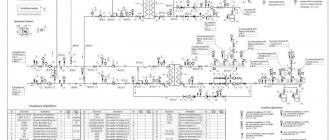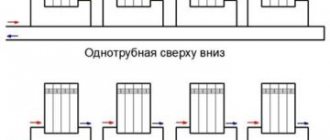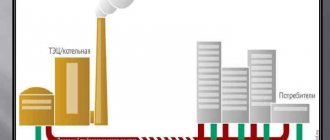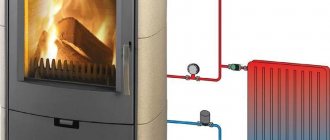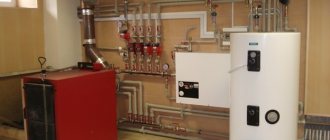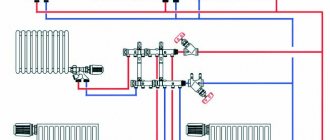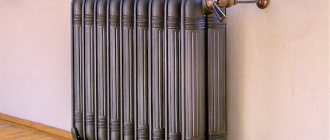For most of us, the term “independence” in relation to a heating system is associated with energy independence, that is, the ability to function without power supply.
In fact, these are two different concepts.
Let's figure out what a dependent and independent heating system is, and what advantages each of them has.
Independent (closed) heating system
Currently, when installing new boiler houses, an independent connection scheme for the heating system has become more often used.
It contains a main and an additional circulation circuit, hydraulically separated by a heat exchanger. That is, the coolant from the boiler room or thermal power plant goes to the central heating point, where it enters the heat exchanger, this is the main circuit. The additional circuit is the heating system of the house; the coolant in it circulates through the same heat exchanger, receiving heat from the network water from the boiler room. The operating diagram of the independent system is shown in the figure: For reference. Previously, bulky shell-and-tube heat exchangers were installed in such systems, which took up a lot of space. This was the main difficulty, but with the advent of high-speed plate heat exchangers, this problem ceased to exist.
But what about the centralized supply of hot water, because now you can’t take it from the mains, the temperature there is too high (from 105 to 150 ºС)? It's simple: an independent connection diagram allows the installation of any number of plate heat exchangers connected to the main pipelines. One will provide heat to the heating system of the house, and the second can prepare water for household needs. How this is implemented is shown in the diagram:
To ensure that hot water always flows at the same temperature, the DHW circuit is made closed with automatic replenishment in the return pipeline. In apartment buildings, the DHW circulation return line can be seen in the bathroom; heated towel rails are connected to it.
It is obvious that operating an independent heating system has many advantages:
- the home heating circuit does not depend on the quality of the external coolant, the condition of the main networks and pressure drops. The entire load falls on the plate heat exchanger;
- it is possible to regulate the temperature in the rooms using thermostatic valves;
- the coolant in a small circuit can be filtered and cleaned of salts, the main thing is that the pipes are in good condition;
- The hot water supply system will contain drinking quality water entering the house through the water main.
However, due to dirty, low-quality coolant in the central network, periodic flushing of the independent heating system, or more precisely, the plate heat exchanger, will be required. Fortunately, this is not so difficult to do. Another disadvantage is the higher costs of purchasing equipment, namely: heat exchangers, circulation pumps and shut-off and control valves. But a closed system is more reliable and safer than an open one, it better meets modern requirements and is better adapted to new equipment.
Advantages and disadvantages of connections
Dependent circuit
Dirty coolant in the main leads to damage to expensive radiators.
Water is supplied and supplied to heating and water supply from the heating main, which leads to a number of advantages:
- simplicity of design and inexpensive cost of subscriber devices;
- the ability of the system to withstand temperature fluctuations;
- smaller reinforcement diameter;
- economical coolant consumption;
- low operating costs.
Negative factors of using a dependent heating system include:
- Formation of dirt, rust and scale in lines. They enter aluminum and bimetallic devices and cause pipe ruptures.
- Frequent pressure fluctuations, water hammer due to reduced water intake. The phenomena can lead to ruptures of polymer reinforcement.
- Low quality coolant, despite cleaning and desalting in the boiler room.
- Difficulty in adjusting temperature even with full bore valves.
To remove blockages, additionally install a dirt trap on the mixer.
Independent circuit
With independent heating, it is possible to install a filter on the coolant and keep the radiators clean.
If there is a closed circuit, water from the plate heat exchanger can be supplied to any wiring. The dependent heat supply scheme has several advantages:
- the temperature of the coolant in the pipes is regulated by the user;
- good energy saving indicators;
- compatibility with any heat carrier;
- absence of impurities in the DHW main;
- the ability to purify and filter water in circuits;
- no risk of pressure surges and water hammer.
The disadvantages of an independent connection include:
- difficult maintenance;
- impossibility of self-repair;
- large financial costs for the organization.
An independent type main saves water consumption by 10-40%.
Open heating systems
Open heat supply systems are characterized by the fact that hot water is collected for consumer needs directly from the heating network, and it can be either full or partial. The remaining hot water in the system continues to be used for heating or ventilation.
With this method, the water consumption in the heating network is compensated by an additional amount of water that is supplied to the heating network. The advantage of an open heating system lies in its economic benefits. During the Soviet period, almost 50% of all heating systems were open type.
At the same time, one cannot discount the fact that such a heat supply system also has a number of significant disadvantages. First of all, this is the low sanitary and hygienic quality of water. Heating appliances and pipeline networks give the water a specific smell and color, various foreign impurities appear, as well as bacteria. Various methods are usually used to purify water in an open system, but their use reduces the economic effect.
An open heat supply system can be dependent by the method of connection to heating networks, i.e. connect through elevators and pumps, or connect according to an independent scheme - through heat exchangers. Let's look at this in more detail.
Dependent heat supply systems
Dependent heat supply systems are systems in which the coolant through a pipeline enters directly into the consumer’s heating system. There are no intermediate heat exchangers, heating points or hydraulic insulation. There is no doubt that such a connection scheme is understandable and structurally simple. It is easy to maintain and does not require any additional equipment, for example, circulation pumps, automatic regulation and control devices, heat exchangers, etc. Most often, this system attracts with its, at first glance, cost-effectiveness.
However, it has a significant drawback, namely, the inability to regulate heat supply at the beginning and end of the heating season, when excess heat appears. This not only affects the comfort of the consumer, but also leads to heat loss, which reduces its initially apparent efficiency.
When energy saving issues become relevant, methods for transitioning a dependent heat supply system to an independent one are developed and actively implemented, this allows heat savings of about 10-40% per year.
Independent heating systems
Independent heat supply systems are systems in which the heating equipment of consumers is hydraulically isolated from the heat producer, and additional heat exchangers of central heating points are used to supply heat to consumers.
An independent heat supply system has a number of undeniable advantages. This:
- the ability to regulate the amount of heat delivered to the consumer by regulating the secondary coolant;
- its higher reliability;
- energy-saving effect, with such a system heat savings are 10-40%;
- it becomes possible to improve the operational and technical qualities of the coolant, which significantly increases the protection of boiler installations from contamination.
Thanks to these advantages, independent heat supply systems have become actively used in large cities, where heating networks are quite extensive and there is a large variation in heat loads.
Currently, technologies for reconstructing dependent systems into independent ones have been developed and are being successfully implemented. Despite significant investment, this ultimately has its effect. Naturally, an independent open system is more expensive, but it significantly improves the quality of water compared to a dependent one.
General information
Dependent system
If the connection diagram is dependent, then the internal distribution system in the building will communicate with each other through the main pipeline, and the coolant from the main will begin to flow through a special unit called an elevator, and then reach the radiators.
An elevator is a mixing unit, and in it the extremely hot coolant from the main is mixed with that which has managed to cool down “in processing”, and as a result, water at a normal temperature is supplied to heating-type devices.
Independent system
But in an independent heating system according to the scheme, the internal distribution system of the building does not have a connection with the main line, it turns out that both systems are separated. Heat energy from the main heat carrier is transferred through internal channels through a heat exchanger. With its help, it is possible to heat cold water from the water supply system for a hot water supply system.
Differences between the two systems
So, let's compare all the advantages and disadvantages of each option. A dependent heating system has two main advantages:
- Simplicity of the device.
- Low cost.
But there are still many disadvantages:
- It is not possible to adjust the temperature of the coolant that enters the internal distribution system. Naturally, there is a special valve in front of the elevator, due to which it will be possible to limit the flow of heated coolant from the main path, but it is simply not designed for such adjustment, and if you try to reduce the volume of water that will flow into the mixing unit, it will lead to the operating mode will be disrupted and circulation will deteriorate.
- The internal distribution system in the building is powered by the main thermal fluid, which, as a rule, is not of the best quality. Moving along a large pipeline network, such an environment will collect huge amounts of scale, sand, rust, and often it also introduces oxygen in large quantities. Such factors often lead to rapid wear of fittings, piping and radiators within the distribution system.
But there are also advantages:
- The amount of heat that enters the internal system can be adjusted within the latitude limit, and this makes heating several times more economical (financial savings compared to a dependent type of heat supply scheme range from 10 to 45%).
- The internal system can be “charged” with a highly purified thermal fluid, and at the same time, building owners will be able to select its chemical composition at their own discretion, for example, use the same antifreeze.
Please note that the larger the heated area of the building, the more profitable it is to use an independent scheme, since saving thermal energy and increasing the service life of elements on a large scale will help offset the costs of arranging the system. At the moment, it is possible to connect to a centralized heating system even using an independent heat supply method
At the moment, it is possible to connect to a centralized heating system even using an independent heat supply method.
Features of work
The transition to a closed system requires financial investments, but these investments pay off in the future. The decision to make the transition is made by the overwhelming majority of companies providing heat supply services to the population. The organization of heat supply work is constructed in various ways; there may or may not be dependence on electrical energy.
A steel or cast iron boiler running on solid fuel can be used as a heat generator. The constant loading of flammable material becomes a significant disadvantage, however, compared to the temperature loss during a power outage, this does not seem to be a serious problem.
To ensure independent heating in a private home, the following technical solutions will help:
- bunker and transport belt (supply of firewood or sawdust, minus - the belt requires electricity to operate);
- pyrolysis boiler (solid fuel is burned at the first stage, and the resulting gas is burned at the second stage);
- top combustion boiler (capable of operating for about 5 days on one burner, a fan is required for operation).
It is impossible to automate the heating system using these methods without the use of electrical energy. An alternative is gas boilers equipped with a mechanical thermostat. If the temperature is lost, the gas supply and heating of the coolant are resumed.
The advantage of an independent heating scheme over an open one is clear, but there are nuances in organizing such a system. Options for creating heat supply using a closed model are characterized by diversity. There is no universal solution; for each specific case, special approaches are practiced; consultations with professionals will help you choose the appropriate option.
Saving resources
The dependent type of closed system provides that water flows to the consumer without passing through heating points. In this case, there is no need to install circulation pumps, devices for regulating heat exchange and automatic control. But there is also a minus - the inability to regulate the temperature in the system.
Independent closed heating systems save energy resources in the amount of 10-40% per year. They allow you to regulate the amount of heat supplied, the temperature of the coolant and improve its quality characteristics, which leads to reliable operation of heating equipment.
An example of an open heating system in the video:
Types of circulation in heating circuits
To deliver heat to the batteries, you need to move the coolant heated by the boiler. Natural circulation is used in the heating system and forced movement of water using a circulation pump. Natural circulation is used in simple heating systems; it requires a minimum of equipment with minimal installation and operating costs.
To implement this method of moving the coolant, a change in the physical properties of water when heated is used. The speed of movement depends on the temperature difference and on the magnitude of hydraulic resistance, which is reduced by increasing the diameter of the pipes.
Open heating circuit
An open gravity heating system with natural circulation has undoubted advantages.
Advantages of open natural coolant circulation:
- simplicity and low installation costs;
- efficiency;
- easily converted into a system with forced circulation; the circulation pump is usually installed in the “return”.
Therefore, the heating system for a one-story house with natural circulation is very popular and is successfully used. The main disadvantages of such heating are high inertia. In addition, the presence of an open expansion tank determines the answer to the question - is it possible to pour antifreeze into the heating system of a house. You can fill it, but it will constantly evaporate, which will make the operation of the system unprofitable.
Closed heating circuit
The coolant in a closed heating system has no contact with atmospheric air. To compensate for thermal expansion, sealed membrane expansion tanks are installed. A closed heating system can have any design; it is equipped with a circulation pump to move the coolant. The absence of contact of the coolant with air significantly increases the service life of pipes and heating circuit equipment.
If during installation the slope of the pipes is provided, then in the absence of mains voltage and the bypass is switched, natural circulation will occur in the closed heating system of the house. Of course, the efficiency of the system will drop, but the heating will be operational and will continue to heat the home.
The main advantages of a closed heating system:
- the use of a sealed expansion tank eliminates the evaporation of liquid; in closed systems, antifreeze can be used as a coolant;
- the absence of contact between water and air protects circuit elements from internal corrosion;
- a closed heating circuit has low inertia and high efficiency;
- the use of a circulation pump allows you to reduce the diameter of the pipes and reduce the cost of purchasing them;
- for heated floors and complex branched circuits, an additional pump is installed in the heating system, which will ensure their efficient operation.
Heating scheme for a private house
Which heating system scheme to choose in a private house?
Heating system diagrams
Before you start designing and building a house, you need to decide how to install the heating system. This is necessary in order to determine:
1. Where will the gas boiler be located and is there a need for a separate boiler room for it?
2.Which heating scheme will work effectively in your home.
3. Location of ventilation and smoke ducts, mark them on the plan and lay a foundation for them.
Heating systems are divided primarily into volatile and non-volatile. Simply put, your boiler needs power supply or not. Of course, you would say better if the boiler is working without power supply, the electricity will suddenly be turned off, but the heating will continue to work. I can’t disagree with you, and so let’s talk about a non-volatile heating system and its advantages and disadvantages.
The main advantage we have already outlined is independence from electricity. Well, perhaps, all the advantages end there. Modern heating systems use electric pumps and, as a rule, control units. An electric pump allows you to reduce the amount of water in the heating system and thereby makes gas consumption for heating more economical.
And also, the pump allows you to install heated floors in the house and hide all the pipes in the walls or floors.
Secondly, heating systems are divided according to the method of connecting pipes to radiators, the main methods are: single-pipe system (Leningradka); two-pipe system and radiant heating system. The choice of heating system is made by an engineer depending on the technical characteristics of your home. I will try to explain in simple language how this is done.
If you are in the Belgorod region, then a specialist from our company will help you choose a rational heating system.
Single pipe heating system
The example shows a diagram of a single-pipe heating system for a house with a total area of up to 100 m2. We see that the largest wing has 5 radiators and a heated towel rail. Here the power of the radiators is small due to the small area of the rooms, and therefore this scheme will work fully. It is not recommended to perform more than 5-6 points on one wing when using a single-pipe heating system.
Two-pipe heating system
A two-pipe heating system differs from a single-pipe heating system in that the water supply to the radiator is carried out not by one, but by two supply and return lines. This allows you to place a larger number of heating devices on one wing and make the heating system more progressive. A two-pipe heating system is more expensive at cost than a single-pipe one, since there are more pipes.
Radiant heating system
If the house is one-story and has a large number of rooms, you can use a radiant heating system. This will make the heating system more efficient. The difference between a radiant heating system and a two-pipe heating system is that water is supplied to the radiator not from the main, but directly from the boiler. The example shows the pipe distribution unit for the beam system.
Summarizing
In this article we talked about heating systems, these are: single-pipe, double-pipe and radiant heating systems. In terms of cost, a single-pipe system is cheaper, but it will not work effectively in all cases. In each case, consultation with a specialist is necessary.
Dependent heat supply scheme
If you imagine the elevator unit of a residential building (you can see what it looks like in the photo), then it is arranged as follows:
- the elevator is separated from the heating main by inlet valves;
- behind them, at the supply and return points, valves or gate valves are located. Hot water supply is connected through them from the supply or return pipelines. Often in modern elevators there are two taps on the supply and return lines, which are separated by a retaining washer. Their purpose is to ensure constant circulation of hot water;
- after inserting the elements to provide DHW, there is a nozzle with a chamber where mixing is carried out. The flow of hotter liquid coming from the direct pipeline under high pressure heats up part of the water in the return and is sent for recirculation;
- house valves shut off the heating system of the building - they are open in winter and closed in the warm season.
Dependent and independent heating systems differ in that in the first version, water enters the hot water supply and heating systems directly from the heating main.
Open Network Package
To assemble an open circuit, you will need the following elements:
- heating equipment;
- pipelines;
- atmospheric expansion tank;
- heating appliances;
- pumping equipment will only be needed for open-type water heating with a pump;
- drain valve;
- tap for filling the network with coolant.
Boiler
Open circuits can work with the following types of boilers:
- It is advisable to use gas heating equipment in regions where there are gas mains. Gas boilers are the most economical, but they are installed after obtaining permission from the gas service.
- Solid fuel units operate on wood, coal, pellets or briquettes. There are long-burning boilers on sale that are economical, efficient, and do not require frequent loading of fuel.
- Electric heaters are not used as often because energy resources are quite expensive.
- Combined type units can operate on two different types of fuel, which makes the equipment non-volatile.
Circulation pump
If we compare natural and forced circulation, the latter is much better because it increases the efficiency of the heating system. Despite the energy consumption of the pump, there is a saving in the energy carrier used by the boiler.
Pumping equipment is selected according to the diameter of the pipes at the insertion point, liquid pressure and productivity
When choosing a pump, pay attention to its technical characteristics
Expansion tank
You can make an expansion tank yourself or buy it. The stainless steel tank is equipped with an opening lid to control the coolant level. A pipe is installed in the upper part of the container to drain excess liquid.
The expansion tank can be installed at the following network points:
- on a remote riser;
- at the highest point of the system;
- on the return pipeline;
- together with pumping equipment that is installed on the supply pipes.
Heating radiators
Open heating can work with the following types of heating devices:
- Cast iron batteries are ideal for open systems because they have great inertia, which ensures energy savings.
- Steel radiators with anti-corrosion coating are lightweight and inexpensive, but it is better to avoid using them. The device cools down quickly, which will lead to frequent operation of the heater and excessive energy consumption.
- When choosing aluminum appliances, give preference to units with anti-corrosion coating. They are valued for their durability, good heat dissipation, light weight and attractiveness.
- The most expensive bimetallic devices. They combine the advantages of steel and aluminum appliances, but are completely devoid of their disadvantages. But they are better used in centralized networks with high pressure.
Pipes
For natural coolant flow, large diameter pipes will be needed.
Pipelines made of the following materials can be used:
- steel pipes are almost never used due to the complexity of installation and heavy weight;
- copper pipelines are the highest quality and most durable, but they are very expensive;
- metal-plastic pipes themselves are not bad, but they are connected to fittings that often leak;
- it is better to choose elements made of cross-linked polyethylene with oxidation protection and reinforcement;
- There is another inexpensive and practical option - polypropylene pipelines with fiberglass reinforcement.
Comparison of solutions
The dependent heating connection scheme has, in essence, only one advantage, but a very important one - low cost of implementation. You can assemble an elevator unit for a small cottage with your own hands from consumer-grade shut-off valves
The only thing noticeable against the background of wiring batteries around the house will be the cost of manufacturing the nozzle - the only exclusive one made, the diameter of which determines the thermal power of the elevator.
What are the assets of an independent scheme?
Incomparably more flexible adjustment of the coolant temperature for the heating system. It is enough just to reduce the flow of coolant through the heat exchanger - and the house will become colder.
- The practical consequence of flexible adjustment of heating to the needs of the home is efficiency. Relative to the dependent system, it is estimated at 10-40 percent.
- Finally, the main thing: in a dependent system we are forced to use water with a lot of pollution. It carries sand, scale and a lot of mineral salts.
There is no talk of using water as drinking water; moreover, in some regions it is undesirable to even wash with hot tap water. An independent circuit makes it possible to use purified water or even non-freezing coolants as a coolant.
It is not a problem to heat drinking water for DHW needs.
Connection options
Currently there are two main connection schemes:
- dependent - considered the simplest, therefore most often used;
- independent - gained popularity relatively recently; it is widely used in the construction of new residential areas.
Below we will look at each method in more detail to find out which solution will be the most effective for ensuring comfort and coziness in your room.
Dependent connection method
This connection option usually requires the creation of in-house heating stations, often equipped with elevators. In their mixing unit, superheated water from the external main network is mixed with the return water, which allows it to be reduced to the required temperature, usually below 100 °C. Thanks to this, the heating system inside the house is completely dependent on external heat supply.
| Advantages | The main feature of the scheme is that water enters the heating and water supply system directly from the heating main, so the costs in this case pay off in a short time:
|
| Flaws | As in any scheme, here you can find not only positive aspects, but also negative ones, among which it should be noted:
|
Connection methods:
- direct connection
; - with elevator
; - with on the jumper
; - with mounting of a pump on the supply or return
; - combined option - elevator and pump
.
Independent connection method
Experts say that this heat supply option makes it possible to reduce resource costs by almost 40%.
In today's situation with their constant rise in price, this will significantly save money in the family budget.
- The operating principle is as follows:
- connection of the heating system of subscribers is made using an additional heat exchanger;
- heating occurs thanks to two hydraulic isolated circuits - the main heating main heats the coolant of the closed internal heating network;
- in this case, no mixing of water occurs.
- The coolant circulates in the heating mechanism due to a circulation pump, which regularly supplies it through the heating elements. An independent connection scheme may provide an expansion tank with a supply of water in case of leaks. In this case, it is possible to maintain the circulation of the coolant with a certain amount of heat even in the event of a heating main failure. In fact, this means that if the supply of hot water through the heating main stops, the temperature in the heated rooms will not drop sharply for a long time.
- The scope of application of this connection method is quite wide. For example, it is used:
There is one condition - the pressure in the return must be more than 0.6 MPa.
- Advantages of the method:
- the instructions allow you to adjust the temperature;
- great energy saving effect.
- Flaws:
- high price;
- complexity of repair and maintenance work.
Comparison of schemes
- The dependent option has one important advantage - low implementation cost. An elevator unit in a small country house is easily assembled with your own hands from shut-off valves, which can be purchased in a store or on the market. The only expensive part will be the nozzle, on which the power of the elevator depends.
- An independent scheme allows you to:
- adjust the coolant temperature;
- increase the efficiency of use, bringing this level to 40%;
- Large amounts of contaminants, such as scale, sand and mineral salts, do not enter the heating system. The coolant can be purified water or antifreeze liquids.
- You can easily heat clean drinking water for hot water needs.
Independent heating system and its types
An independent heating system is divided, in turn, into two subtypes according to the implementation of the method of circulating energy in pipelines:
- Gravitational, otherwise called non-volatile. The liquid moves through the pipes due to the different densities of the cold and heated substances. Therefore, the heated carrier coming from the heat exchanger tends upward due to its lower specific gravity, while the cold carrier, on the contrary, settles at the lowest points of the heating main. This feature imposes several strict requirements for full functionality:
- The heat exchange device or hot water boiler, if the heating is autonomous, must be placed at the lowest point of the building. If radiators are also installed on this floor, you will have to install a pit below floor level.
- All horizontally laid pipelines should be mounted at a slope of two to three degrees in the direction of movement of the coolant in the pipe. That is, the feed will have a positive angle relative to the general vector, and the return will have a negative angle.
- To minimize the negative impact of hydraulic resistance, the bore diameter of the pipes must be large. For a two-story cottage with five to seven heated rooms, a diameter of 35 millimeters will be sufficient. The principle of more is better is in full effect here.
- Circulating or energy dependent. The coolants of the centralized supply system and the heat distribution hydraulics have no physical contact with each other. Heat transfer from one to another occurs in the so-called heat exchanger, which is a tank in which there are tubes with liquid circulating through them. That is, an independent connection of the heating system makes it possible to flexibly adjust the temperature regime of heated structures, simplify the modification and expansion of the network and save on heating costs. There are also features:
- The cost of construction significantly exceeds the cost of the first method.
- Increased demands are placed on the quality of secondary circuit coolants.
- There is almost always a need for a continuous power supply to ensure the circulation process.
Comparison of reliability and durability
The practice of operating technically complex and multi-level systems shows that they are less maintainable and more often must be subject to preventive inspections with maintenance measures. It cannot be said that independent connection of the heating system reduces the overall level of reliability and safety (in some cases it even increases it), but the tactics for carrying out repair and restoration activities should be at a different and more responsible level.
At a minimum, an increase in labor and time resources will be required when inspecting the heat exchanger and adjacent piping. Possible uncontrolled accidents at this site can lead to damage to the pipeline. Therefore, experts recommend installing several sensors that monitor pressure, temperature and tightness. The latest manifold cabinets also provide for the use of self-diagnostic systems for continuous monitoring of the system condition. As for the closed heating infrastructure, such control and measuring equipment will also not be superfluous, but in this case its need is not so high.
Heating network pipes
Currently, domestic ones are in disrepair. Due to the high wear and tear of communications, it is cheaper to replace the pipes for the heating main with new ones than to engage in constant repairs.
It is impossible to immediately update all old communications in the country. During the construction or major renovation of houses, new pipes are installed to reduce heat loss several times. Pipes for the heating main are made using a special technology, filling the gap between the steel pipe located inside and the shell with foam.
The temperature of the transported liquid can reach 140°C.
Using polyurethane foam as thermal insulation allows you to retain heat much better than traditional protective materials.
Stove heating
Stoves and fireplaces are used to heat homes. For cottages, these options are ineffective, since they do not ensure uniform distribution of heat throughout the rooms. It is better to choose them for use in dachas.
To decide which heating is more suitable for a private home, you need to choose the cheapest and most accessible fuel in your area. The price of artificial heating of a residential building directly depends on its consumption and cost. There is no universal option. Gas remains the most economical source of thermal energy
In areas where there are no main gas pipelines, you should pay attention to solid fuel and electrical resources
Electricity addiction
Now let's return to energy dependence. When does a heating system need electricity to function, and when can it be done without?
Solid fuel boilers
The canonical solution is a conventional steel or cast iron boiler with a water jacket in the firebox and mechanical adjustment of the blower using a thermostat. This unit is completely energy independent.
The photo shows a classic solid fuel boiler.
However, this design has an important drawback: the boiler requires frequent loading of fuel. Three technical solutions allow you to make heating as independent from humans as possible:
- A hopper and a conveyor belt supply new portions of sawdust or pellets as the fuel burns out. Electricity is required at a minimum for the transporter to operate.
- A solid fuel pyrolysis boiler divides combustion into two stages: pyrolysis of wood with a limited supply of oxygen and combustion of the resulting gas. In this case, the gas combustion chamber is located below the pyrolysis chamber. The movement of combustion products against the vector of natural draft requires the operation of an electric fan.
- An upper combustion boiler can operate on one load of coal for up to five days. Only the top layer of fuel smolders; air is supplied to it from top to bottom, and the ash is carried away by a stream of hot combustion products. Air circulation is provided by... that's right, an electric fan.
Gas
Non-volatile gas heating boilers use manual ignition using a piezoelectric element and flame regulation by a mechanical thermostat. When the main burner is extinguished at a high coolant temperature, the pilot burner continues to operate.
Floor-standing gas boiler with piezo ignition.
Boilers with electronic ignition stop the gas supply completely when idle. As soon as the coolant cools below the critical temperature, the discharge ignites the main burner and heating resumes. In addition, electricity often drives a blower fan that supplies air to the burner.
Which scheme is better? If you have frequent power outages, a non-volatile gas heating boiler would be more appropriate. Precisely because he is able to do without electricity in principle. On the other hand, these devices are less economical: up to 20% of the total gas consumed is spent maintaining the pilot flame.
Another useful feature that gas-independent heating boilers lack is the ability to control the weather and control it using an external thermostat, which takes the temperature, for example, in a remote room. Of course, we are also not talking about programming the temperature for a day or a week.
Solara
Everything is simple here: solar boilers are COMPLETELY identical to gas boilers with electronic ignition. Only the burners differ. In fact, a lot of dual-fuel units are being produced.
It is clear that without a forced-air fan and electronic ignition, the devices simply will not be able to work.
There are no rules without exceptions. The independent household heater OB1 0010 is equipped with its own generator and does without external power, generating electricity for the fan independently.
Gas boilers
A gas boiler can also be non-volatile. This model works according to the following principle: the user lights the pilot burner, which from that moment burns constantly. It lights up the main one.
All safety automation is mechanical, that is, its action is based on changes in the volume of materials when the temperature changes.
Double-circuit gas boiler
The disadvantage of a non-volatile gas boiler is the following: the pilot burner, although seemingly quite small, consumes quite a lot of gas. Much more economical are energy-dependent boilers that have electronic ignition.
Safety and efficiency of independent heating systems
To be able to save money on heating, several conditions must be met:
- Develop and approve the project with the permitting authorities. Without an approved GIP and a project agreed upon with all authorities, all modifications will be illegal. Therefore, you will not be able to use the results.
- Install or reconstruct existing equipment according to the design solution.
- Install a heat energy meter. This will allow you to pay for the received thermal energy exactly in the volume in which it was consumed.
- Provide the necessary level of automation or manual regulation. CHP plants do not respond particularly quickly to temperature changes in weather conditions and can continue to fire their boilers to the fullest. And through the heat exchange tank, unclaimed energy will be transferred to the networks of consumers who open windows and vents from excess heat.
We heat your home without using gas
So, despite the widespread belief that using alternative sources of home heating is very expensive, heating without gas and electricity is a completely affordable option. In addition, this way you can quickly and efficiently heat any room. Although gas and electricity are the most modern systems, they can be easily replaced by alternative heating, which, by the way, was used by our ancestors.
Today, such heating is quite common, especially in those areas that do not have such convenience as a gas pipeline. Stoves, which serve as the main element of such heating, can be used not only for heating rooms, but also for cooking.
Firewood is one of the most affordable heating methods
Such solid fuel heating without gas or electricity is a great way to heat your home - private or countryside. The principle of its operation is that the coolant (usually water) is heated and then goes to the heating radiators, giving off its heat to the premises.
This is affordable fuel heating, and also safe based on the standards that exist today.
Technologies do not stand still and heating for a dacha without gas is now the same full-fledged method of heating your own home as traditional methods. Due to the fact that there are many models of boilers on the equipment market created using the latest technologies, any user can choose the appropriate option for himself, despite the fact that he lives in a remote area and has problems with power fluctuations.
| Solid fuel boiler | Pyrolysis boiler |
Dependence of systems on electricity
Energy dependence of systems is defined as the ability to operate in the presence or absence of electricity. Non-volatile communications are installed in conditions of long-term lights out. Several methods are used for normal heating operation:
- Installation of an electric generator or inverter batteries. The devices start powering after the network is de-energized.
- Providing energy-independent heat generation. You will need an automatic boiler - pellet, liquid fuel or gas. The equipment operates without electricity, but uses basic fuel uneconomically.
- Creation of gravitational pressure. The liquid moves through the difference in density when heating and cooling. Heated water masses go up, cooled ones go down. Gravity pressure is created by installing the boiler at the lowest point and sloping the horizontal pipeline along the movement of water.
When implementing circulation or energy-dependent heat supply, you will need a circulation pump. The system is connected to pipes of any diameter; special convectors and heated floors also work for heating. The water temperature is maintained at a given level. In case of a lack of electricity, generators are installed.
Infrared heating
For infrared heating of greenhouses use:
- infrared lamps for greenhouses
- infrared heaters
If we take into account the fact that such an energy carrier as electricity is the most expensive, then it becomes clear why the plan heating system is gaining momentum.
Possessing high efficiency, they heat plants and soil without heating the air.
Then, the already heated soil and the structure of the room release heat into the surrounding atmosphere. Moreover, it is warmer below, i.e. the soil warms up well.
Savings become possible due to the fact that the infrared heater does not work constantly. It can be equipped with a thermostat that controls the temperature. The IR heater turns on only to maintain the required temperature.
It is essential that infrared radiation is completely harmless to people and plants. By using infrared heating in a greenhouse, it is possible to create different temperature bands for different types of plants, which is very comfortable for planting.
This heating is ideal when you need to raise the temperature in the greenhouse in a short period of time. The heaters reach the set temperature in just ten minutes.
Dependent system
The coolant flowing along the highways enters directly into the home. The system is also called open, since the selection of coolant for the purpose of heating the building (also to provide warm water) occurs from the outlet pipeline (another name is the supply pipeline). This scheme is popular for buildings designed for several families and buildings of government agencies, shops, banks, and many other buildings.
If the temperature of the coolant inside the supply pipeline has not reached 95 degrees Celsius, it is sent to the heating apparatus. When the temperature reaches this limit, but still remains less than 105 degrees Celsius, intervention of the mixing elevator unit is required. It is installed at the entrance to the cottage so that liquid, gas or antifreeze from radiators is added to the hot coolant so that the latter becomes warm and not hot.
The dependent system operates based on the laws of molecular physics and thermodynamics. Antifreeze or other coolant gets to the top, which causes high pressure to form at the outlet of the heating boiler, and at the same time, a slight vacuum is created at the inlet of the heat generator. After this, the liquid tends to enter an area where the pressure is lower. This system operates according to the natural circulation of coolant.
This scheme was very often used in the USSR. The dependent heating system functions properly and without interruption. Repair, installation, materials require small investments. There is no need to install additional pipes used to supply warm water to the room.
Minuses:
- waste and debris from pipelines end up inside the battery;
- when equipment is repaired or replaced, pressure drops and water hammer often occur;
- the coolant cannot be called high-quality, since it runs along old highways, which are most often already rusty;
- the quality of the water or antifreeze mixture affects the thermostatic valves, they break;
- it is almost impossible to regulate the temperature at home on your own;
Types of dependent systems
The single-pipe system is ideal for private homes. This circuit is closed. A pipeline is laid from the heating apparatus, and the radiators are connected one by one and then taken back to the boiler.
Typical single-pipe heating circuit
There are horizontal and vertical patterns. The first is more suitable for one-story houses; it is carried out from below and above the floor, the batteries are installed at the same level. In the vertical direction from the boiler, the wiring moves upward and is already distributed among the batteries there. After cooling it descends.
The system does not require many components for installation, is easy to install, does not cause problems during operation and is inexpensive. It is ideal for small country houses; it can be installed without the help of professionals. The disadvantages include the fact that radiators that are closer to the heating device (boiler) heat up more and faster than those located further away.
Leningradka is one of the most popular systems, a system invented back in Soviet times. In it, all heating devices are combined into a single circuit through which the coolant moves freely. A special boiler heats the water or antifreeze mixture; radiators are usually connected along the walls, mainly near the windows. Leningradka has a very low cost, easy installation and a good level of performance, but it requires balancing during operation.
Spider - the system was considered obsolete not so long ago, but still remains popular due to its low cost. There is no need to install vertical wiring around the perimeter of the entire house, but the rooms are still heated evenly. The main advantage of the Spider is that the system is not dependent on the electric generator. It is very easy to adjust during operation. Installation of this type of system is difficult. It only needs to be installed in the attic, which increases the cost of additional insulation. Antifreeze cannot be used in such a system due to its evaporation inside the expansion tank. Such a system spoils the interior; only people with certain skills are allowed to install it due to the complex design stage.
Forced circulation
Neutralization of almost all of the listed disadvantages is achieved by introducing a circulation pump into the system.
As a result, the coolant receives an additional impulse, thanks to which it effectively overcomes the hydraulic resistance of the pipeline. Single-pipe heating system wiring is currently the most popular solution in private homes. The installation location for the pump can be any section of the highway. However, it should be borne in mind that when rubber elements (gaskets) are exposed to hot water, the service life of the pump is noticeably reduced. Therefore, they try to install the device on the return pipe, because The coolant there is not so hot. A coarse filter must be installed in front of the pump to prevent various contaminants from entering the mechanism. When connecting all instruments and devices, it is recommended to use shut-off valves and bypasses. This will significantly simplify repair and maintenance activities at individual units: in this case, there is no need to stop the entire system and completely drain the coolant.
Strengths of forced circulation heating circuits:
- Possibility of using more complex branched circuits, leading to an increase in the total length of the circuits.
- There is no need to increase the diameter of the pipes. Thanks to the pump, sufficient pressure is created inside the system for movement and uniform distribution of liquid.
- The circulation has a stable speed. This indicator is not affected by the level of heating of the coolant and the installation of the accelerating manifold.
- There is no need to organize inclination angles on horizontal sections of the pipeline, because A pump is used to stimulate the movement of the coolant.
- It becomes possible to insert control devices on all batteries, which ensures the maintenance of an optimal heating level, reducing energy consumption and heating costs.
There are also disadvantages:
- The need for electrical power.
- Noise from a running pump.
- The need for additional capital investments (when compared with the gravity scheme).
Neutralizing them usually does not cause difficulties. To maintain a stable energy supply, an autonomous electric generator is being installed. Systems that provide the possibility of switching to a natural circulation mode have proven themselves very well. To reduce the noise from a running pump, it is usually installed in a non-residential area.
Which heating system is more profitable and why?
With the onset of the cool season, from autumn to early spring, every owner of his home thinks about heating it. One option for achieving this goal is a dependent heating system. It is a consistent, direct method of transferring the thermal properties of the coolant from the heating source & CHP & to the end user & your heating device. The pressure throughout the entire heating network is constant and equal to the pressure in the heating system.
Connection diagram for batteries in a heating system with natural coolant circulation: 1 - Boiler; 2 - Overflow pipe; 3 - Expansion tank; 4 - Supply pipeline; 5 - Heating and water heating control valves for each heating device; 6a - Diagonal battery connection; 6b - Lateral battery connection; 7 - Return water supply; 8 - Sewer drain; 9 - Valve for draining water from the heating system; 10 - Heating and water heating control valves for the entire system; 11 — Valve for replenishing the system with water; 12 — Fine mechanical filter; 13 - Mayevsky crane.
Circulation in the heating system is achieved by a pressure difference in the supply and return pipelines.
To maintain the nominal operating mode of the entire heating system, a CHP employee needs to monitor the pressure in the supply pipeline; on your part, all that is required is to paint the pipeline and pay for the use of heat.
Dependent heating schemes
- direct connection diagram;
- scheme using an elevator;
- diagram with installation of a pump on a jumper;
- diagram with installation of a pump on the supply line;
- diagram with installation of a pump and an elevator at the same time.
Dependent heating helps reduce coolant costs.
Each of them has its own differences, advantages and disadvantages, but the main thing is that the heating is efficient. Thus, the direct connection scheme is easy to install and operate, but the main drawback is the lack of heating in the cold season, according to the CHP schedule, and overheating in the warm season, which does not subsequently have a very good effect on human health and the appearance of indoor plants. The same drawback can be attributed to all other heater connection schemes. But, looking at the economic indicators obtained per year when using this particular method of heat transfer, the management of the thermal power plant is very interested in maximally adapting the temperature to the optimal one for a comfortable stay in the room. Every year, such enterprises make changes to the heat supply scheme to the consumer, purchasing more expensive equipment, so its cost to the consumer increases in direct proportion to their costs.
A dependent heater connection scheme, in contrast to an independent one, allows you to obtain a larger temperature difference in the heating system, as well as reduce coolant consumption.
In addition, the connection pipelines are used with a smaller diameter, and the costs of operating the necessary equipment are also significantly reduced. An independent heating connection scheme is more economical and controllable by the end consumer of heat, since it involves automation, which is its main difference from the above type of heating. Date: September 25, 2022
Mixing coefficient values
Design temperature in the heating network, °C
Design temperature in the heating system, °C
Normal operation of the elevator occurs at H/h = 8-12 (H is the available pressure at the inlet; h is the resistance of the heating system).
It should be borne in mind that the value of the design pressure in front of the elevator is directly proportional to the resistance of the heating system. Therefore, an increase in the resistance of the heating system, for example, by 1.5 times will cause an increase in the design pressure R by also 1.5 times.
Connection with pump on jumper (c). In the event that water mixing cannot be accomplished using an elevator, install a pump on the jumper between the supply and return pipelines of the heating system. Mixing using an elevator cannot be performed for the following reasons: the pressure at the connection point is insufficient for its normal operation; the required thermal power of the mixing unit is large and goes beyond the power of manufactured elevators (usually more than 0.8 MW - 0.7 Gcal/h).
When installing mixing pumps in residential and public buildings, it is recommended to use silent, foundationless pumps. When installing mixing pumps designed for large flows, centrifugal type K and KM are used as mixing pumps. The pump flow is equal to G2 = 1.1G1, and the pressure should be equal to H = 1.15h (where h is the resistance of the heating system).
Connection to the pump on the heating system supply pipe (d). A pump is installed on the supply pipeline if, along with mixing water, it is necessary to increase the pressure in the supply pipeline at the connection point of the heating system (the static height of the heating system is higher than the pressure in the supply pipeline at the connection point).
The pump flow is equal to G3 = 1.1 (1 + U)G1, and the pressure should be equal to:
where h is the resistance of the heating system; hn is the difference between the static height of the heating system and the piezometric height in the supply pipeline of the heating network at the connection point, m.
Connection to the pump on the return pipe of the heating system (e). A pump is installed in the return pipeline if, along with mixing water, it is necessary to reduce the pressure in the return pipeline at the connection point of the heating system (the pressure is greater than permissible for the heating system). The pump flow in this case is equal to C3 = 1.1 (1 + U)G1 and the pressure must have a value that provides the required pressure in the return pipeline.
Independent accession (e). If the pressure in the return pipeline in the heating network is higher than the permissible pressure for the heating system, and the building has a significant height or is located at a high place in relation to adjacent buildings, then the heating system is connected according to an independent circuit.
According to an independent scheme, it is allowed to connect buildings with a height of 12 floors or more. The independent scheme is based on separating the heating system from the heating network using a heat exchanger; as a result, the pressure in the heating network cannot be transferred to the coolant of the heating system. Coolant circulation is carried out using circulation pumps type K and KM. The pump flow is determined by the formula
where Q is the power of the heating system, kJ/h (Gcal/h); C is the heat capacity of water, J/(kg h); T11, T22 - design water temperature in the supply and return pipelines of the heating system, respectively, °C
It happens that private houses located within the city are located next to central heating networks, and some are even connected to them. Of course, nowadays the priority is individual heating, and centralized heating is gradually becoming a thing of the past. But if the house is already connected to the network or there are problems with the autonomous system, then you need to use what is available. To work together between a heat source and consumers, a dependent and independent heating system is used. What they are, as well as the pros and cons of both schemes will be outlined in this material.
Refusal from gas, wood and coal
Traditional heat sources, used for heating for many years, can be abandoned. Surprising as it may seem, it is quite real. Many ardent opponents argue that it is impossible to replace natural resources with environmentally friendly analogues. The alternative is the energy of the sun, the power of the wind, the heat hidden in the bowels of the earth, waste from production and human activity. Such options are relevant in the modern world, given the general pollution of the environment.
Alternative sources can provide a country house with electricity and thermal energy
Another significant advantage is tangible savings when using environmental sources of spontaneously renewable energy. At first glance, it seems that this is unreasonably expensive and is unlikely to pay off. Having understood in more detail the features of each method, you can see that the eco-project pays off in 4-7 years, and then only the current costs of maintaining the used mechanisms in working order remain.
The possibility of fully replacing conventional fuel with an alternative one has been proven by more than one real example. Homeowners around the world are turning to green heating options. In our country, only a few decide to radically change their usual fuel, which is becoming more expensive every year.
The main problem with ecofuels is the significant capital investment at the initial stage. After all, you first need to calculate in detail the amount of energy required for a particular house or cottage. Then find out what type of eco-resources are most beneficial in a particular area. Next, you have to draw up a plan for the location of the energy-generating equipment, buy everything you need and install it.
If all these issues are dealt with by relevant specialists, then the final cost of eco-heating will be very high. To save money, you can try to do it yourself. To do this, you will have to immerse yourself in the topic of alternative energy sources in order to refuse to attract outside help. In this case, the cost of the project will be several times cheaper.
It is the second option that many owners of private houses choose. Their practice proves that becoming energy independent is quite possible. You can completely or partially replace traditional fuel - it all depends on the size of the household, financial capabilities at the initial stage, and the chosen heating option.
